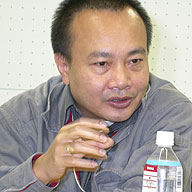An Interview with Rithy Panh
I Make Films to Give “Testimony”
Q: The behavior of the former guards was all based on facts, right? The four-minute one-cut scene left me trembling.
RP: Their gestures were things they actually did at that time. The order isn’t necessarily correct, but memory engraved within the body is very important. They aren’t proficient in expressing themselves through words, so gestures serve as the body’s way of speaking.

The gestures also contain things that were “taught.” These were beaten into them when they became guards. For example when taking prisoners for questioning, first the guards handcuffed them, then put on the blindfold and removed the shackles from their ankles. Any different order is impossible, and there’s no way the gestures are wrong. The order of gestures from daily life got mixed up, but actions that were trained had soaked into the body. Actions like pressing false charges, hitting a prisoner with a stick, or torture were all taught, so they reenacted them faithfully following the procedures. And then the wording they used came back. For example, the handcuffs usually used today are opened with keys, but the handcuffs used then were fastened with screws. So the expression for “taking off the handcuffs” becomes “undo the screw,” and that’s what they actually ended up saying. By placing their bodies within the S21 space, the language of the “body” returned.
Q: It’s wonderful filming without pretension or waste.
RP: The most important thing in filming is “time.” I don’t like short shots. I want to see and feel people “living” in the duration of shots that are as long as possible. “Silence” is also important. There’s an expression that “silence speaks,” which I think is very important.
So filming requires a crew that understands language. There wasn’t a cameraman like that in Cambodia, so I trained him that the rhythm of language is important, and that it’s impossible to film correctly unless you understand language. I constantly am saying that a good cameraman is someone who can make listening important. After finishing a day of filming and looking at what was shot, there were times when I admonished the cameraman, saying “you weren’t really listening right there, were you?” or “you couldn’t adjust to the other person’s rhythm right there.”
Getting the appropriate height and distance is also important. For me the appropriate distance is where I can be touched by the subject, and if I want I could touch them, and on the other hand if they wanted to hit me, it’s a distance where they could hit me.
Q: The final shot is a wonderful conclusion.
RP: When I filmed the final shot, it was the rainy season. A really strong wind was starting up, lighting was beginning and everything around was covered with dust. I thought it would be possible to get a good shot, but we didn’t have a tripod so I put the camera on the ground. I didn’t know if the footage would be usable, but if I tried shooting handheld the camera shook. I absolutely never resign myself to blurriness because of the circumstances. I don’t accept that. In the end, I think that the camerawork has to be stable. I put the camera on the ground, pushed the start button, and that shot is what I filmed.
When the wind started swirling around the dust at that location, I intuited that precisely this scene would be appropriate for the ending. The phrase “In Memory” was something I thought of later. We had been visiting the former prison for three years, pursuing the “dust of memory.” We were battling against forgetting. The fight between “memory” and “forgetting” is extremely unequal, but my thinking is that there are two kinds of forgetting. There’s complete “nothing” where no records remain, and there’s forgetting that happens with records being left behind. I selected the latter. Leaving a record was absolutely necessary.
(Compiled by Kato Takanobu)
Interviewers: Kato Takanobu, Yabe Atsuko / Interpreter: Catherine Cadou
Photography: Yamazaki Ryo / Video: Kondo Yoko / 2003-10-13
